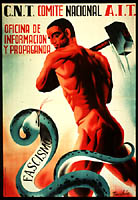 |
C.N.T., Comité Nacional A.I.T., Oficina de Información y Propaganda. Fascismo
[CNT, National Committee AIT, Office of Information and Propaganda. Fascism]. Signed: Monleón. Oficina de Información y Propaganda. Gráficas Valencia, Intervenido, U.G.T. C.N.T. Lithograph, 3 colors; 100 x 69 cm.
|
|
Here the Spanish conflict
is presented as the struggle of man against beast. The revolutionary--red--hued,
naked, and muscular--wields his hammer against a serpent coiled
about his body; the man's nakedness reflects the purity of his cause,
in contrast to the insidiousness of the coiled snake of fascism.
The caption announces that the poster was produced by the anarcho-syndicalist
trade union Confederación Nacional del Trabajo (CNT)
in conjunction with the international anarchist organization Asociación
Internacional de los Trabajadores (AIT). The presence of the
AIT initials on anarchist propaganda gives the illusion that the
domestic movement was backed by an international organization similar
to the large and vigorous Communist International, or Comintern.
In fact, by 1936 the AIT listed fewer than 100,000 members and was
able to provide relatively little aid to Republican Spain. As the
war progressed, the Communists, as administrators of Russian arms
and supplies, progressively dominated the Republican camp. Lacking
this international clout, the Spanish Anarchists, despite being
numerically much larger than the Communists at the beginning of
the war, found themselves increasingly marginalized and powerless.
The artist Manuel Monleón (1904-1976), like his more famous
contemporary, Josep Renau, was a graphic designer who specialized
in photomontage techniques. He was committed to left-wing politics
and in 1933 joined the radical artists' group, the Unión
de Escritores y Artistas Proletarios, formed by Renau. In the
same year his work was included in an exhibition of revolutionary
art in Madrid. Monleón contributed to three left-wing Valencian
publications before the war: Nueva Cultura, Orto,
and Estudios; the latter was an anarchist-backed magazine
which advocated free-love, and whose covers were often graced by
Monleón's pictures of voluptuous, naked females. Between
1936 and 1939, Monleón produced propaganda posters for the
CNT and the Partido Sindicalista. At the war's end, he was
imprisoned for four years, after which he took exile in South America,
first in Colombia and later in Venezuela. He returned to Spain in
1962.
The poster was produced
under the aegis of the UGT and CNT control committee, which controlled
the production process in Valencia until the Republican government
transferred there from Madrid in November 1936. We can thus date
the poster to the first months of the Civil War.
|




